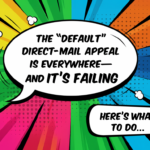Call me lazy. I prefer to call myself busy.
Either way, I’m always looking for ways to make life easier.
And you and I are in the same boat: We create fundraising messages, and it’s hard work. Especially this time of year. We pretty much give up on the idea of “free time” starting in September.
So, based on many years of intense research, here are a few ways to keep your fundraising life as manageable as possible:
Start with a Brief
One of the worst ways to over-pack your time is for something to go wrong that forces you to do over work you’ve already done. It always seems to happen when you can least afford to go back to square one – and there’s a reason for that: When we’re extra busy, we hurry. When we hurry, we cut corners and even forget important things. That’s when we end up doing the work a second time, this time getting it right.
That’s where the Brief comes in: It’s a document that puts in writing the key elements of your fundraising project. It may seem like a needless extra step that you can skip, just this once. The point is to get the important things nailed down before you start spending serious time on it – not after.
A good brief, circulated before work starts among those who have to approve the final project, can also improve workplace relationships. How many times has a lack of getting it in writing led to there being two conflicting ideas of what a project was going to say … and nobody knew until you’d already done the work?
(You can learn all about what a great fundraising brief contains by taking the Moceanic online course, 7 Steps To Creating Record-Smashing Direct Mail – available for members of The Fundraisingology Lab.)
Write the Reply Device First
When I stumbled across this labor-saver a few years ago, it took my breath away with how much of a difference it made for me. It’s pretty simple: When you know where you’re going, the trip is a lot easier, with fewer wrong turns and less confusion.
So you write the reply device before everything else. That may seem like it’s out of logical order, but this saves me hours every time I do it.
Write the Thank You Letter Next
Like writing the reply device first, writing the thank you first really helps you get into the emotional space that you are hoping to guide donors towards. Just thinking carefully about the language you’ll use to say thank you guides the way you’ll ask. I think it’s like the way envisioning hitting the target before you throw the dart prepares you to get all the subtle movements right.
This step assumes that you write specific thank-you letters for each fundraising project you do. If you aren’t doing that, you should! It improves donor retention by improving your thanking. (And you might want to take our amazing online course How to Write Your Best Ever Donation Thank You Letter Every Time – only available for members of The Fundraisingology Lab.)
Recycle the Good Stuff
Would you send your mother the same letter twice? Probably not. Not on purpose, anyway.
Because it’s very likely Mom is paying close attention to whatever you send her.
In that way, she is very different from the vast majority of donors. They are paying less attention. Few of them will notice if you send an appeal that’s very similar to last year’s appeal – or even exactly the same. Someone among them might notice (maybe your mother is one of your donors), but they aren’t going to complain or be less likely to donate.
In fact, there’s a lot of evidence that people become more likely to respond to a message they’ve already seen.
So if last year’s appeal was a success, send it again this year. If you need to revise it a bit to bring it up to date, go ahead. But there’s no need to re-invent this particular wheel.
And if you have a really amazing story that just makes your point and gets through to people every time you tell it, use it more than once.
Separate Your Writing from Your Editing
Every time you write a fundraising project, the first draft is considerably more poorly constructed than the final product.
When you write a fundraising project, the first draft is a more poorly written than the final product.
In fundraising, the first draft is worse than the final draft.
The first draft is worse than the final draft.
Your first draft is bad.
How often have you written something the way I just did? You write a sentence and immediately see that it’s not very good, so you revise it. That one isn’t so great, so you try again. Until you are finally satisfied.
Twenty minutes have gone by, and you’ve written only one sentence.
It’s the worst possible way to write. It takes forever. And in the end, you still may not be happy with what you’ve written.
Overcome this by just admitting it: Your first draft is not great. Neither is mine. Or every other writer. That’s the nature of writing.
Knowing this basic truth will save you so much time.
You won’t have to waste time and energy trying to make every sentence just right before you can move on. You just get everything down on the screen. Then go back later and make it better.
Quickly getting it all down: that’s writing.
Cleaning it up and making it better: that’s editing.
They are fundamentally different activities. They call on different parts of your brain.
If you try to mix them together, you won’t make good progress at either one.
Let your bad first draft be a bad first draft. It’s going to be bad no matter what you do, so go for it.
You can go back and fix it.
I know a writer who literally wears a “writer” hat when she’s writing and an “editor” hat when she’s editing. It reminds her what she’s doing and not to try to wear both hats at the same time. (She’s a good writer. Very good.)
This will also free you from writer’s block, which is mostly fear of being bad. Once you know you’ll be back later to fix the mess, you can make progress and not get bogged down by fear of bad writing or the false belief that you must get everything right the first time.
This is not always easy. But it’s a huge time saver. And it removes a lot of frustration from your life.
Want to learn more about the art of survival as a professional fundraiser? Find your way forward by scheduling a free 25-minute call with Fundraisingologist Sean Triner. He’ll give you great free advice, and help you identify which Moceanic Coaching+ program might be right for you. Click here to book your call.
Related Blog Posts:










